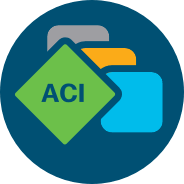Businesses, service providers, and carriers face more pressure than ever. As cloud computing and multimedia content availability continue to grow, companies face pressure to keep delivering quality service while revenues remain flat. As a result, more businesses are turning to software-defined networking (SDN) technology to revamp their network designs and operations to keep pace.
Cisco, a long-time player in the digital communications arena, offers a proprietary version of SDN called application-centric infrastructure. The technology provides network provisioning and management based on a company’s software needs. Many organizations have turned to Cisco ACI because of its hardware abstraction and use of automation.
What is ACI Networking?
Cisco’s ACI networking solution bases its network infrastructure on defined network policies. It relies upon a shared OS called ACI Fabric OS. The shared OS gets used by all systems within the ACI network, making it possible for different ACI network switches to turn policies into infrastructure models.
One reason for the ongoing popularity of Cisco ACI is that it takes an application-centric approach to networking. Companies can centralize application profiles to streamline network management. The design of Cisco ACI lets organizations manage traffic per application versus individual VLANs or devices.
Cisco ACI Networking Components
Cisco API is made up of two primary components.
- Cisco Application Policy Infrastructure Controller (APIC): Controller for the SDI responsible for setting up policies to define the network infrastructure.
- Nexus 9000 Switches: Rely on the ACI Fabric OS to connect directly with APIC and construct policy-based infrastructure. Nexus 9000 switches can be one of two types.
All endpoints within ACI networking use Leaf switches to make network connections. Organizations can deploy Cisco ACI through different models, including:
- On-site
- Cloud (public, private, hybrid)
- SD-WAN edge environments
ACI networking relies upon several other building blocks.
- Endpoint groups (EPG): Classify and group workloads that are similar.
- Bridge domains (BD): A layer inside the ACI fabric that lets users define the default gateway for hosts attached to the fabric.
- VRFs: Virtual routing and forwarding that contains tables, IPs, and layer 3 routing instances. They remain joined to a tenant and can’t be separated.
- Contracts: Policy constructs that define how EPGs communicate.
- Micro-segmentation: A security technique lets users automatically assign endpoints to EPGs.
Tips for Working with Cisco ACI
Now that we have a deeper understanding of how CISCO ACI works, let’s look at some tips to help you get the most out of this powerful networking tool.
1. Use the Fabric Manager
Cisco’s centralized management system lets users see everything within the ACI fabric. It simplifies and automates everyday tasks required to manage the ACI fabric, including the following:
- Monitoring performance
- Provisioning new applications
- Troubleshooting problems
You can avoid a lot of problems by using the Cisco ACI Fabric Manager to optimize fabric performance.
2. Use APIC Templates to Automate Deployment
There are a lot of components to configure when you’re getting ready for deployment, like the firewall, server, and load balancer. If you try to do this manually, you can make mistakes. It’s also very time-consuming.
ACI templates speed up the process of defining configurations for your application components. The only thing you need to do is specify the parameters for a specific deployment. Automating the process reduces manual labor and helps you deploy applications consistently.
3. Establish High-Level Naming Conventions
Set up a naming standard for all your configured objects. Make sure you choose a naming convention that makes it easier to operate the ACI fabric. For example, you can use an underscore as a delimitator. They’re not used in system-generated strings, which makes them ideal to use as part of your naming conventions.
4. Setup a Common Policy Model for Your Network
Cisco ACI lets organizations manage and automate the configuration of network devices from a central location. You can apply a consistent policy across your entire network, which simplifies tracking down and troubleshooting any problems.
Having a standard policy model in place also lets you seamlessly roll out network changes. For example, if you want to update your company network’s firewall rules, all you have to do is apply the policy update within Cisco ACI and let them automatically roll out to your connected devices. As your network grows, you can quickly add new devices that use the same policy.
5. Validate Changes Using Cisco ACI Simulator
Before you roll your deployment to production, put any changes through the ACI simulator for testing. It is a duplicate of the actual ACI fabric, so you can see how your updates will respond before implementation. That helps your team avoid mistakes that could be harmful in production.
It’s also a good practice to validate production environment changes within the ACI simulator. You can look for any errors and ensure that your updates have the intended effect.
Benefits of Using Cisco ACI
Your organization can use Cisco ACI to establish a software-defined data center, which provides your company with the following:
- More flexibility: You can implement your organization’s network as code, making it easier to update configurations as your business needs change.
- Consistency: By abstracting away the underlying details of the infrastructure, it becomes easier to create and configure your desired network environment.
- Scalability: Cisco ACI’s use of automation makes it easier to implement essential changes and expand the network along with your business.
- Hybrid environment support: Because it supports on-premises and cloud infrastructure, you can deploy ACI environments wherever you need them.
Another benefit to using Cisco ACI is its’ ability to integrate with other third-party tools like Open APIs. The solution also supports service changing, letting your company create solutions designed to meet any required security or networking requirements.
Find the Right Networking Solution
R2 Unified Technologies provides small and mid-sized businesses (SMBs) with the resources and skills needed to build their optimal networking environment. Find out more about how we can help by setting up a one-on-one consultation.




